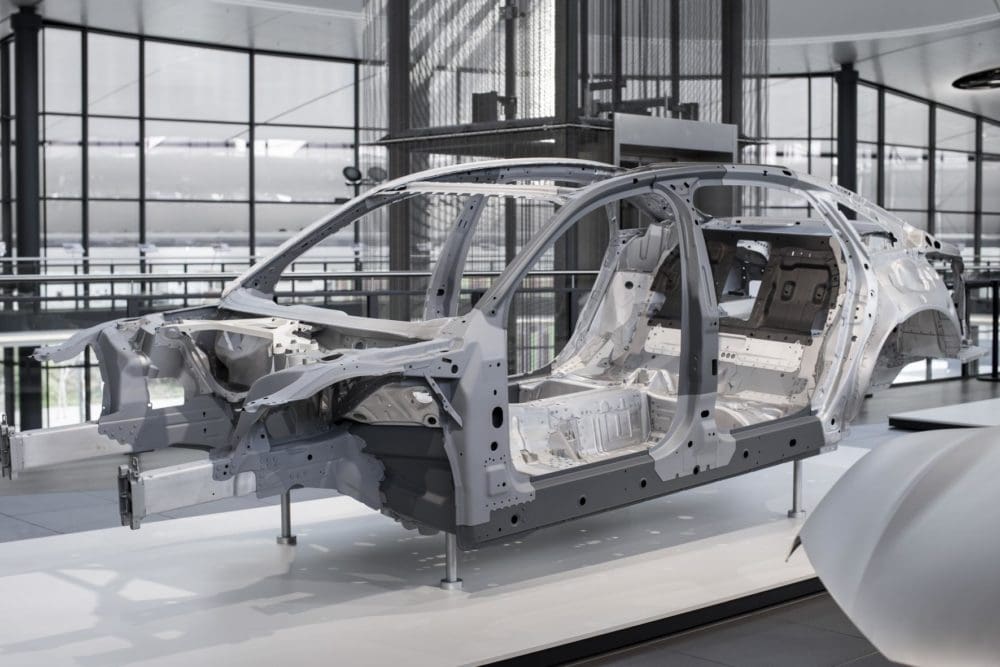



With a mix of aluminium, steel, magnesium and carbon fibre-reinforced polymer (CFRP), Audi says it is establishing a new stage in multi-material construction in the Audi Space Frame (ASF) for the next generation of the Audi A8 – in keeping with the principle “the right material in the right place and in the right amount.”
The new car’s torsional rigidity – the critical parameter for precise handling and pleasing acoustics – surpasses the values of its predecessor by a factor of about one quarter.
In terms of its overall dimensions, an ultra-high-strength, torsionally rigid rear panel made of CFRP is the largest component in the occupant cell of the new Audi A8, and it contributes 33 percent to the torsional rigidity of the total vehicle. To optimally absorb longitudinal and transverse loads as well as shearing force, between six and 19 fibre layers are placed one on top of the other, ensuring a load-optimised layout. These individual fibre layers consist of tapes 50 millimetres wide and can be placed individually in a finished layered package, with any desired fibre angle and minimal trimming of the fibres. The innovative direct-fibre layering process specially developed for this purpose makes it possible to entirely dispense with the normally needed intermediary step of manufacturing entire sheets. Using another newly developed process, the layered package is wetted with epoxide resin and sets within minutes.
A high-strength combination of hot-formed steel components make up the occupant cell, which comprises the lower section of the front bulkhead, the side sills, the B-pillars and the front section of the roof line. Some of these sheet metal blanks are produced in varying thicknesses using tailoring technologies – meaning they are customised – and others also undergo partial heat treatment. That reduces weight and increases the strength, especially in areas of the vehicle that are particularly critical for safety.
The aluminium components make up 58 percent of the new Audi A8 body, the largest share in the mix of materials. Cast nodes, extruded profiles and sheets are the elements characteristic of the ASF design. New heat-treated, ultra-high-strength cast alloys attain a tensile strength of over 230 MPa (megapascals). The corresponding yield strength in the tensile test is over 180 MPa, and for the profile alloys it is higher than 280, i.e. 320 MPa – significantly higher values than seen previously.


In the event of a frontal collision, the forces generated are distributed to three impact buffers in the front end.
In addition to the complete redevelopment of the Audi Space Frame for the next generation A8, the production halls at the Neckarsulm location were specially built for the upcoming model. A total of 14,400 metric tonnes of steel were needed just for construction of the new, 41-metre-high body shop, twice as much steel as was used for the Eiffel Tower in Paris.
The highly complex yet energy-efficient production operation uses 14 different joining processes, including roller hemming at the front and rear door cutouts. This mechanical, “cold” technology is used to join the aluminium side wall frame to the hot-formed, ultra-strong steel sheets at the B-pillar, roof line and sills. The engineers realised improvements of up to 36 millimetres at the door cutouts compared to the predecessor model. That in turn makes getting in and out of the car even more comfortable and widens the driver’s field of vision around the A-pillar.
Audi says it is alone among the premium automakers in its development of remote laser welding for use with aluminium. Exact positioning of the laser beam in relation to the welding edge reduces the risk of hot cracking during the production process. The new process makes it possible to control precisely the penetration depth of the laser by means of the heat input. In this way, process control can immediately determine the gap width between parts being joined, and this can effectively be closed using regulating controls. The laser beam’s high feed rate and low energy use reduce the CO2 emissions of this production step by about one fourth.
This new process also results in a 95 percent savings on recurring costs in series production because it eliminates the need for costly process controls required with conventional laser welding.
Since the first-generation A8 was introduced in 1994, the company has built more than one million production cars in accordance with the Audi Space Frame design principle.
© Motorworld Media 2023
Registered Office: 4 Capricorn Centre, Cranes Farm Road, Basildon, Essex. SS14 3JJ
Company Number: 8818356
Website designed by Steve Dawson